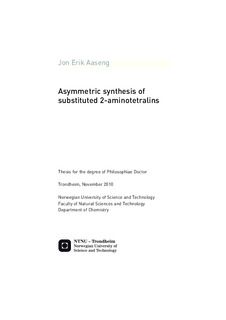| dc.contributor.advisor | Gautun, Odd Reidar | nb_NO |
| dc.contributor.author | Aaseng, Jon Erik | nb_NO |
| dc.date.accessioned | 2014-12-19T13:21:03Z | |
| dc.date.available | 2014-12-19T13:21:03Z | |
| dc.date.created | 2010-11-10 | nb_NO |
| dc.date.issued | 2010 | nb_NO |
| dc.identifier | 369350 | nb_NO |
| dc.identifier.isbn | 978-82-471-2400-0 (printed ver.) | nb_NO |
| dc.identifier.isbn | 978-82-471-2401-7 (electronic ver.) | nb_NO |
| dc.identifier.uri | http://hdl.handle.net/11250/247593 | |
| dc.description.abstract | Presented in this thesis are the results obtained from the project: Asymmetric synthesis of substituted 2-aminotetralins. The initial goal was to establish new or improved routes to enantiopure 2-aminotetralin (2-AT) derivatives. The motivation for this project was based on the diverse applications various 2-ATs represent as biologically active compounds. Despite the role of 2-aminotetralins as interesting target molecules, reflected by the massive research activity in the field, no general and cost efficient route has really been established.
Chapter 1 in this thesis gives an introduction to 2-ATs as biologically active compounds, as well as a brief survey of the concepts of chirality and asymmetric synthesis. Aziridines are also presented, given their role as key intermediates in our developed strategies (chapters 2-4).
In chapter 2, a total synthesis of substituted (S)-2-ATs is presented, starting from natural L-aspartic acid. Two 2-AT derivatives were successfully synthesised, but especially one step (ring-closing to tetralones) proved difficult, providing up to 41% yield only.
Chapter 3 is directly based on the experiences we made in the former chapter, and presents an improved route from the same starting point (chiral pool strategy utilising L-aspartic acid). Again we struggled with one specific cyclisation reaction (up to 36% yield), but the remaining steps provided overall good yields.
In Chapter 4, a different approach has been targeted, i.e. asymmetric aziridination of 1,2-dihydronaphthalenes. Here, various copper, rhodium and ruthenium catalytic systems were tested with alternative nitrogen sources. While we were able to achieve quite good results for non-substituted 1,2-dihydronaphthalene, substituted substrates provided only mediocre yields and enantioselectivity. Aziridines were selectively ring-opened by catalytic hydrogenation to their respective N-protected 2-ATs in good yields. | nb_NO |
| dc.language | eng | nb_NO |
| dc.publisher | NTNU | nb_NO |
| dc.relation.ispartofseries | Doktoravhandlinger ved NTNU, 1503-8181; 2010:209 | nb_NO |
| dc.relation.haspart | Aaseng, J. E.; Gautun, O. R.. Synthesis of substituted (<em><em>S</em></em>)-2-aminotetralins via ring-opening of aziridines prepared from L-aspartic acid ß -<em><em>tert</em></em>-butyl ester.. Tetrahedron. (ISSN 0040-4020). 66: 8982-8991, 2010. <a href='http://dx.doi.org/10.1016/j.tet.2010.09.025'>10.1016/j.tet.2010.09.025</a>. | nb_NO |
| dc.relation.haspart | Aaseng, J. E.; Gautun, O. R.. Synthesis of (<em><em>S</em></em>)-2-amino-7-methoxytetralin and isoindolo[1,2-a]isoquinolinone derivatives from L-aspartic acid.. . | nb_NO |
| dc.subject | 2-aminotetralins | en_GB |
| dc.subject | asymmetric synthesis | en_GB |
| dc.subject | aziridines | en_GB |
| dc.title | Asymmetric synthesis of substituted 2-aminotetralins | nb_NO |
| dc.type | Doctoral thesis | nb_NO |
| dc.contributor.department | Norges teknisk-naturvitenskapelige universitet, Fakultet for naturvitenskap og teknologi, Institutt for kjemi | nb_NO |
| dc.description.degree | PhD i kjemi | nb_NO |
| dc.description.degree | PhD in Chemistry | en_GB |

